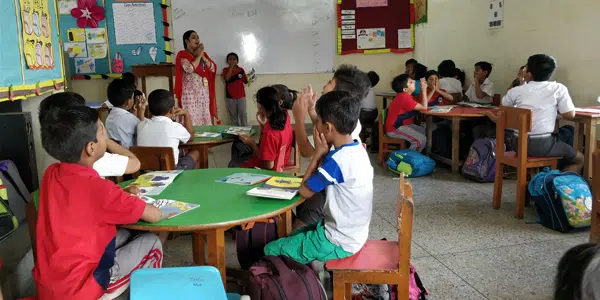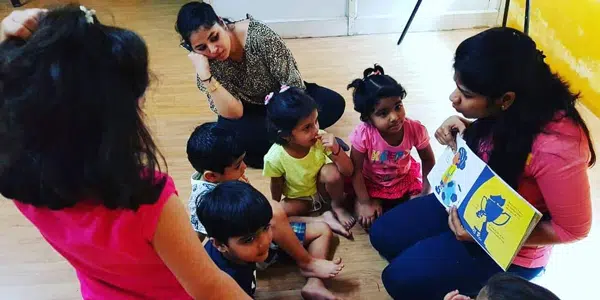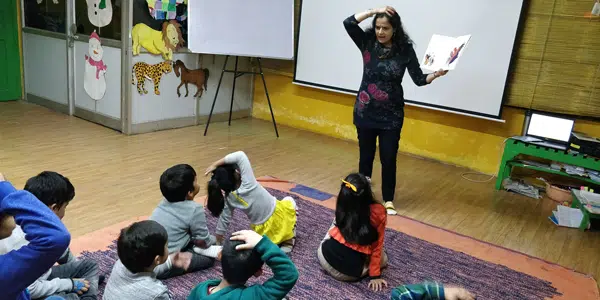Literary instruction routines that educators must integrate in their classrooms
A sound reading routine helps ensure not just a strong language foundation but also fosters cognitive development in children. Reading plays an important role in success in later life. The sooner a child is introduced to books the more likely it is for him/her to grow fond of books and reading.
The National Education Policy (NEP) 2020 emphasizes the importance of well-stocked school libraries and digital libraries to attain the goal of foundational literacy for all children by the year 2025.
All children are different and hence reading routines and instructions vary from child to child. So as to create a reading culture in the classroom and develop a lifelong love for books and reading, the educator must introduce books and read in an innovative manner in the classroom.
Here are three important literacy instructions that may help you as an educator understand the learning needs of your students and help them read better.
Even though these may sound, all the same, they are not. Each instructional routine can help your child grow in a different way. Once you understand what these instructions do, you will be able to help your child become a stronger reader!
What is Guided Reading?
This is an instructional approach where the educator supports small groups of students, around 3-5 children per group, formed on the basis of similar reading abilities, skills set, and learning needs. The educator spends about 10-20 minutes per group, taking care of decoding, fluency, comprehension, vocabulary, and more. The idea is to help the children read accurately with the appropriate speed that supports comprehensiveness. While the students read the text, mostly on their own, the educator observes their reading style, speed, pronunciation and even initiates a discussion around the book, its plot, and characters, etc.

The core idea behind this approach is to closely monitor the reading and comprehension abilities and support the students to read by themselves, while also closely reviewing their progress. As the educator moves from one group to the other, he/she takes notes on each child’s progress and also moves them into different groups accordingly. The guided reading approach is not only for students struggling with reading fluency, and comprehension skills but also for the ones who are evolving as readers.
The way to do this is by introducing students to a book as per their reading level, where they can read the text with some fluency but at the same time, they find it challenging to decode some parts of the book. For instance, if a child is not able to comprehend a sentence in the first attempt, then re-reading the text may help or a visual aid like an illustration in the book may assist the child in comprehending the text better. At this point, the educator may intervene and guide the child.
In order to implement this routine effectively, introducing leveled books is crucial. It is also important for the collection to be vast so it provides a different reading experience and variety to the students.
In my experience as an educator, I have found storyweaver.org a wonderful platform for a level-wise reading list. Books by Dr. Seuss, Usborne early readers, and the I Can Read series provide a wonderful level-wise grouping too.
Choosing a level-appropriate book as per the group’s ability will help students improve their reading abilities immensely. As an educator, this level-wise selection of books will ease the process of regrouping for you. Also, this will help you effectively evaluate each child’s progress in terms of fluency, comprehension, and reading abilities individually in the group. Based on this assessment, you may reshuffle the groups after a few days and challenge the students to escalate their reading abilities.
Procedure for Guided Reading
- Short reading sessions of 20-25 minutes at a time
- A pre-reading routine where the educator talks about the cover page, book title, cover illustrations. The educator may encourage children to make predictions of the storyline.
- Once they start reading, the educator may observe each child and take notes as per fluency, speed, and enthusiasm. Don’t forget to offer support and prompts wherever needed.
- Once the book has been read, the educator must discuss the same. This will provide you with an understanding of the reading and comprehension abilities of your students.
For very young children. It is important for the educator to observe the child’s attempts to develop different reading strategies to decode the written text. While informal assessments can be made by taking notes during the session and at the end of the term, students may be asked to re-read certain books to establish fluency and comprehensiveness, more formal assessment can be done by way of developing group-wise checklists and using established running record tools. Evaluation is the most crucial component because the whole point of guided reading is not labeling the kids as per their reading level but enabling them to read more challenging texts with support. As per concept developers, Irene C. Fountas and Gay Su Pinnell “In guided reading, you meet students where they are and lead them forward with intention and precision.”
What is Shared Reading?
Shared reading happens when the educator reads from a big book or an enlarged illustrated version of it, so that students may see it clearly and follow along. The educator encourages the students to join in as he/she reads the text in the book. The educator also supports and guides the group from time to time. By reading aloud enthusiastically and with expressions, the educator models what fluent reading sounds like. The idea behind this interactive reading experience is to help children enjoy the process of reading and gain the confidence to read independently.
The most encouraging way to do this is to start with books that have a rhyme and rhythm quality to them. Books with vivid language and repeated text reinforce word recognition and encourage children to read independently. Also, books with illustrations help grasp reluctant readers’ attention.

Procedure for Shared Reading
- A pre-reading activity: An introduction to the book by way of a discussion on the book title, cover illustrations, author, storyline predictions.
- Move on to reading fluently at a steady and natural pace with expressions, while pointing at each word.
- Pausing to point out certain difficult words and even explaining their meaning and context.
- During reading, the educator may want to modulate his/her voice, changing it to match the characters.
- Pause occasionally and interact with students asking them to share their inferences. Encourage them to look for clues in the story text and make predictions.
- Ask a range of questions like, ‘What do you think happens next?’ or ‘ Who is this new character?’
- Encourage students to join in and repeat a character’s dialogues, gestures and actions to make the experience fun and increase the readers’ confidence.
- Read the same book at least 3-5 times over a period of time. The educator may pick a new aspect each time. Sometimes focusing on the plot, characters, illustrations, word recognition, difficult words, etc.
- Engage the students in post-reading activities like, asking the students to narrate the story in their own words, art and craft activities, worksheets, among others.
Shared reading is not evaluative by the very nature of its concept. It is used as an engagement tool to create curiosity around books, turn non-readers into readers, and make them active learners, building their capabilities for comprehension, expressions, and word recognition. What this concept really puts into practice, at the very core, is the reading of the text by the children from early years, where they start to perceive themselves as readers. Eventually, preparing them for reading at elevated levels in the future.
What is Read-Aloud?
As the name suggests read-aloud is an instructional routine where a chosen book is read aloud by the educator or the narrator to a group of students. This is the most simple yet the most effective instructional approach for second language learners. Even early learners reap hugely from this, as they begin making a connection with the written word and their world, even before they have started reading. When an educator reads aloud with fluency and expressions, it helps children construct meaning with text and this prepares them for understanding more complicated written text later.
As this routine provides an opportunity to introduce new words to children and encourages them to learn words beyond those they encounter in everyday conversations, it hugely contributes to the overall development of their language skills.

Procedure for Read Aloud Routine
- The educator must define the learning objective of the book/session before the session starts. Creating a lesson plan around the book is an effective way to do this.
- It is important for the person reading the book to be thorough with the text in the book. If the educator/narrator practises reading the book aloud in their own time, by marking the pause points, voice modulation, facial expressions, body-language, it will prepare them well for the session.
- Start by choosing a book that has rich text on themes that children may like. Engaging characters and vivid illustrations always capture their attention. An age appropriate book that appeals to a child’s interest helps him/her form connections with the things they see around. The educator may try to pique the interest of the students by briefly talking about the book they are about to read. Probably give away something funny or intriguing to help them get interested in the book they are about to be read.
- Reading with appropriate voice-modulation as per the narrative and characters helps the narrator engage the visual, listening and emotional senses of the children.
- Post session, the children may be given an opportunity to express themselves by engaging in a dialogue on what they thought of the story, the characters, and the plot. If they were to rewrite the story or create a sequel what would they do or if they were a character. The students may also be engaged by way of imaginative art, a performance or writing activities.
Read Aloud sessions not only develop a love for reading but also good listening habits, they help children grow in many ways. They naturally absorb new words, new ideas, and language structures. Read-aloud routines help build imagination, vocabulary, language skills, cognition, comprehension, among other benefits. According to Burkins & Yaris, “Read aloud is a commercial for learning to read.”
Out of these three instructional practices, even though the students do the least actual reading during a ‘Read-Aloud’ routine where they do not decode words, but simply listen and comprehend, in my experience as an educator, ‘Read-Aloud’ is one of the most effective routines and has proved successful in creating a lifelong love for books and reading in children. Students do the most work during ‘Guided Reading’, where they read the vast majority of the text word for word and then comprehend it. ‘Shared Reading’ falls somewhere in between, as the teacher and students share the work of decoding and comprehending the text.
All three reading routines are enriching inclusions in the classroom and have proven results in inculcating progressive reading behavior in students. The educator may put these into practice as per the age, readiness, and interest of their students and help them fall in love with books and reading.
